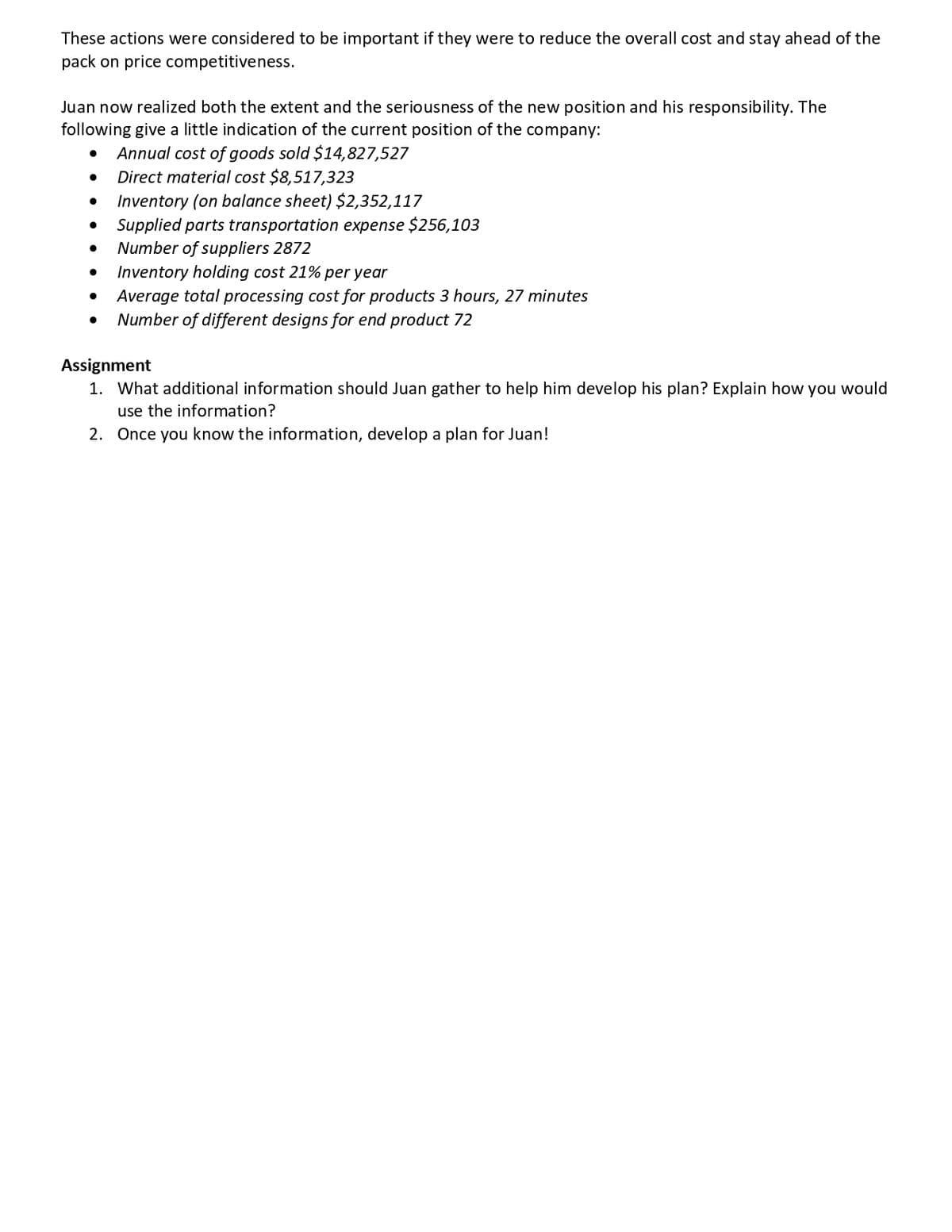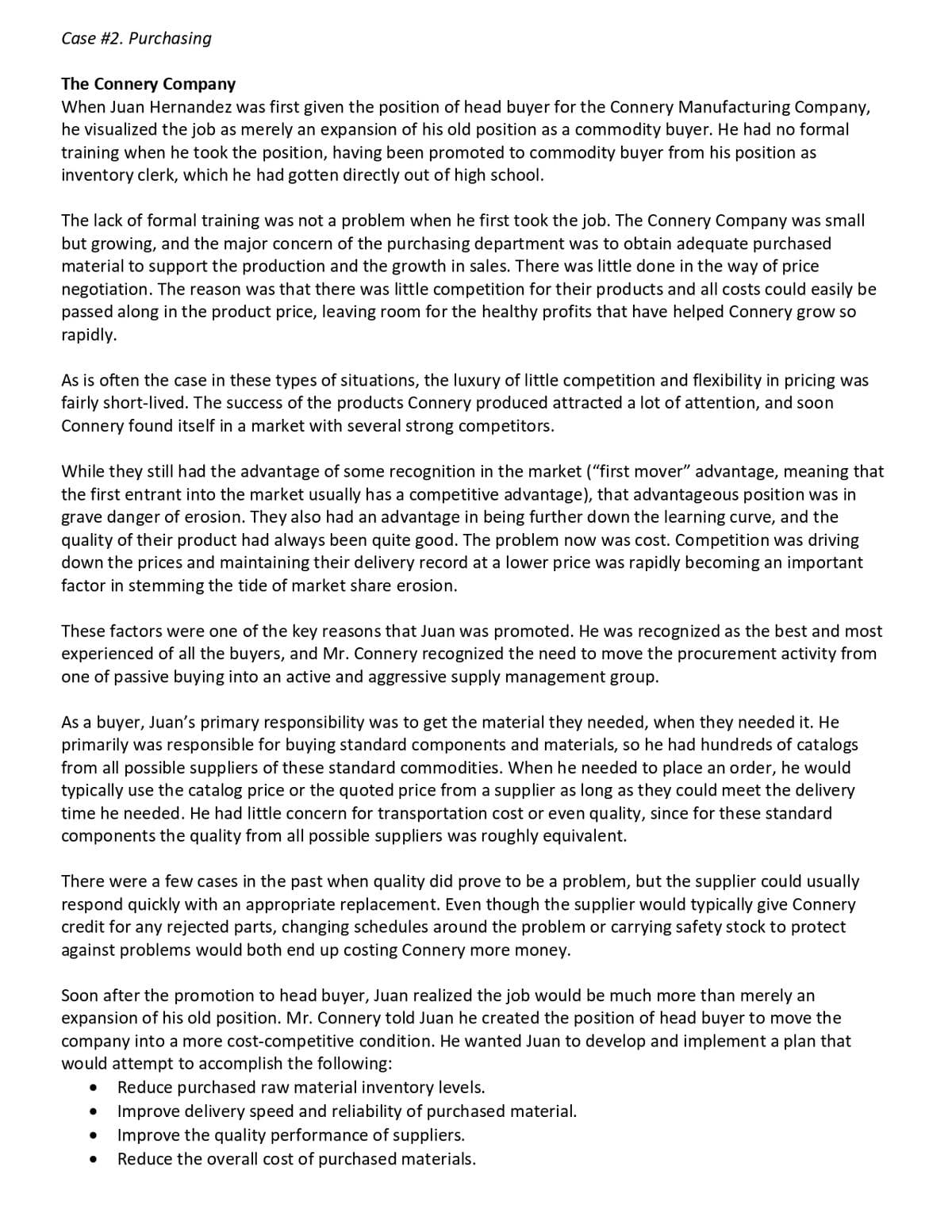These actions were considered to be important if they were to reduce the overall cost and stay ahead of the pack on price competitiveness. Juan now realized both the extent and the seriousness of the new position and his responsibility. The following give a little indication of the current position of the company: ● Annual cost of goods sold $14,827,527 Direct material cost $8,517,323 ● Inventory (on balance sheet) $2,352,117 Supplied parts transportation expense $256,103 Number of suppliers 2872 Inventory holding cost 21% per year ● ● ● ● Average total processing cost for products 3 hours, 27 minutes Number of different designs for end product 72 ● Assignment 1. What additional information should Juan gather to help him develop his plan? Explain how you would use the information? 2. Once you know the information, develop a plan for Juan!
These actions were considered to be important if they were to reduce the overall cost and stay ahead of the pack on price competitiveness. Juan now realized both the extent and the seriousness of the new position and his responsibility. The following give a little indication of the current position of the company: ● Annual cost of goods sold $14,827,527 Direct material cost $8,517,323 ● Inventory (on balance sheet) $2,352,117 Supplied parts transportation expense $256,103 Number of suppliers 2872 Inventory holding cost 21% per year ● ● ● ● Average total processing cost for products 3 hours, 27 minutes Number of different designs for end product 72 ● Assignment 1. What additional information should Juan gather to help him develop his plan? Explain how you would use the information? 2. Once you know the information, develop a plan for Juan!
Practical Management Science
6th Edition
ISBN:9781337406659
Author:WINSTON, Wayne L.
Publisher:WINSTON, Wayne L.
Chapter2: Introduction To Spreadsheet Modeling
Section: Chapter Questions
Problem 20P: Julie James is opening a lemonade stand. She believes the fixed cost per week of running the stand...
Related questions
Question

Transcribed Image Text:These actions were considered to be important if they were to reduce the overall cost and stay ahead of the
pack on price competitiveness.
Juan now realized both the extent and the seriousness of the new position and his responsibility. The
following give a little indication of the current position of the company:
●
Annual cost of goods sold $14,827,527
Direct material cost $8,517,323
Inventory (on balance sheet) $2,352,117
Supplied parts transportation expense $256,103
Number of suppliers 2872
● Inventory holding cost 21% per year
Average total processing cost for products 3 hours, 27 minutes
Number of different designs for end product 72
●
●
●
●
Assignment
1. What additional information should Juan gather to help him develop his plan? Explain how you would
use the information?
2. Once you know the information, develop a plan for Juan!

Transcribed Image Text:Case #2. Purchasing
The Connery Company
When Juan Hernandez was first given the position of head buyer for the Connery Manufacturing Company,
he visualized the job as merely an expansion of his old position as a commodity buyer. He had no formal
training when he took the position, having been promoted to commodity buyer from his position as
inventory clerk, which he had gotten directly out of high school.
The lack of formal training was not a problem when he first took the job. The Connery Company was small
but growing, and the major concern of the purchasing department was to obtain adequate purchased
material to support the production and the growth in sales. There was little done in the way of price
negotiation. The reason was that there was little competition for their products and all costs could easily be
passed along in the product price, leaving room for the healthy profits that have helped Connery grow so
rapidly.
As is often the case in these types of situations, the luxury of little competition and flexibility in pricing was
fairly short-lived. The success of the products Connery produced attracted a lot of attention, and soon
Connery found itself in a market with several strong competitors.
While they still had the advantage of some recognition in the market ("first mover" advantage, meaning that
the first entrant into the market usually has a competitive advantage), that advantageous position was in
grave danger of erosion. They also had an advantage in being further down the learning curve, and the
quality of their product had always been quite good. The problem now was cost. Competition was driving
down the prices and maintaining their delivery record at a lower price was rapidly becoming an important
factor in stemming the tide of market share erosion.
These factors were one of the key reasons that Juan was promoted. He was recognized as the best and most
experienced of all the buyers, and Mr. Connery recognized the need to move the procurement activity from
one of passive buying into an active and aggressive supply management group.
As a buyer, Juan's primary responsibility was to get the material they needed, when they needed it. He
primarily was responsible for buying standard components and materials, so he had hundreds of catalogs
from all possible suppliers of these standard commodities. When he needed to place an order, he would
typically use the catalog price or the quoted price from a supplier as long as they could meet the delivery
time he needed. He had little concern for transportation cost or even quality, since for these standard
components the quality from all possible suppliers was roughly equivalent.
There were a few cases in the past when quality did prove to be a problem, but the supplier could usually
respond quickly with an appropriate replacement. Even though the supplier would typically give Connery
credit for any rejected parts, changing schedules around the problem or carrying safety stock to protect
against problems would both end up costing Connery more money.
Soon after the promotion to head buyer, Juan realized the job would be much more than merely an
expansion of his old position. Mr. Connery told Juan he created the position of head buyer to move the
company into a more cost-competitive condition. He wanted Juan to develop and implement a plan that
would attempt to accomplish the following:
● Reduce purchased raw material inventory levels.
Improve delivery speed and reliability of purchased material.
Improve the quality performance of suppliers.
Reduce the overall cost of purchased materials.
●
●
●
Expert Solution
This question has been solved!
Explore an expertly crafted, step-by-step solution for a thorough understanding of key concepts.
Step by step
Solved in 2 steps

Recommended textbooks for you

Practical Management Science
Operations Management
ISBN:
9781337406659
Author:
WINSTON, Wayne L.
Publisher:
Cengage,

Operations Management
Operations Management
ISBN:
9781259667473
Author:
William J Stevenson
Publisher:
McGraw-Hill Education

Operations and Supply Chain Management (Mcgraw-hi…
Operations Management
ISBN:
9781259666100
Author:
F. Robert Jacobs, Richard B Chase
Publisher:
McGraw-Hill Education

Practical Management Science
Operations Management
ISBN:
9781337406659
Author:
WINSTON, Wayne L.
Publisher:
Cengage,

Operations Management
Operations Management
ISBN:
9781259667473
Author:
William J Stevenson
Publisher:
McGraw-Hill Education

Operations and Supply Chain Management (Mcgraw-hi…
Operations Management
ISBN:
9781259666100
Author:
F. Robert Jacobs, Richard B Chase
Publisher:
McGraw-Hill Education


Purchasing and Supply Chain Management
Operations Management
ISBN:
9781285869681
Author:
Robert M. Monczka, Robert B. Handfield, Larry C. Giunipero, James L. Patterson
Publisher:
Cengage Learning

Production and Operations Analysis, Seventh Editi…
Operations Management
ISBN:
9781478623069
Author:
Steven Nahmias, Tava Lennon Olsen
Publisher:
Waveland Press, Inc.